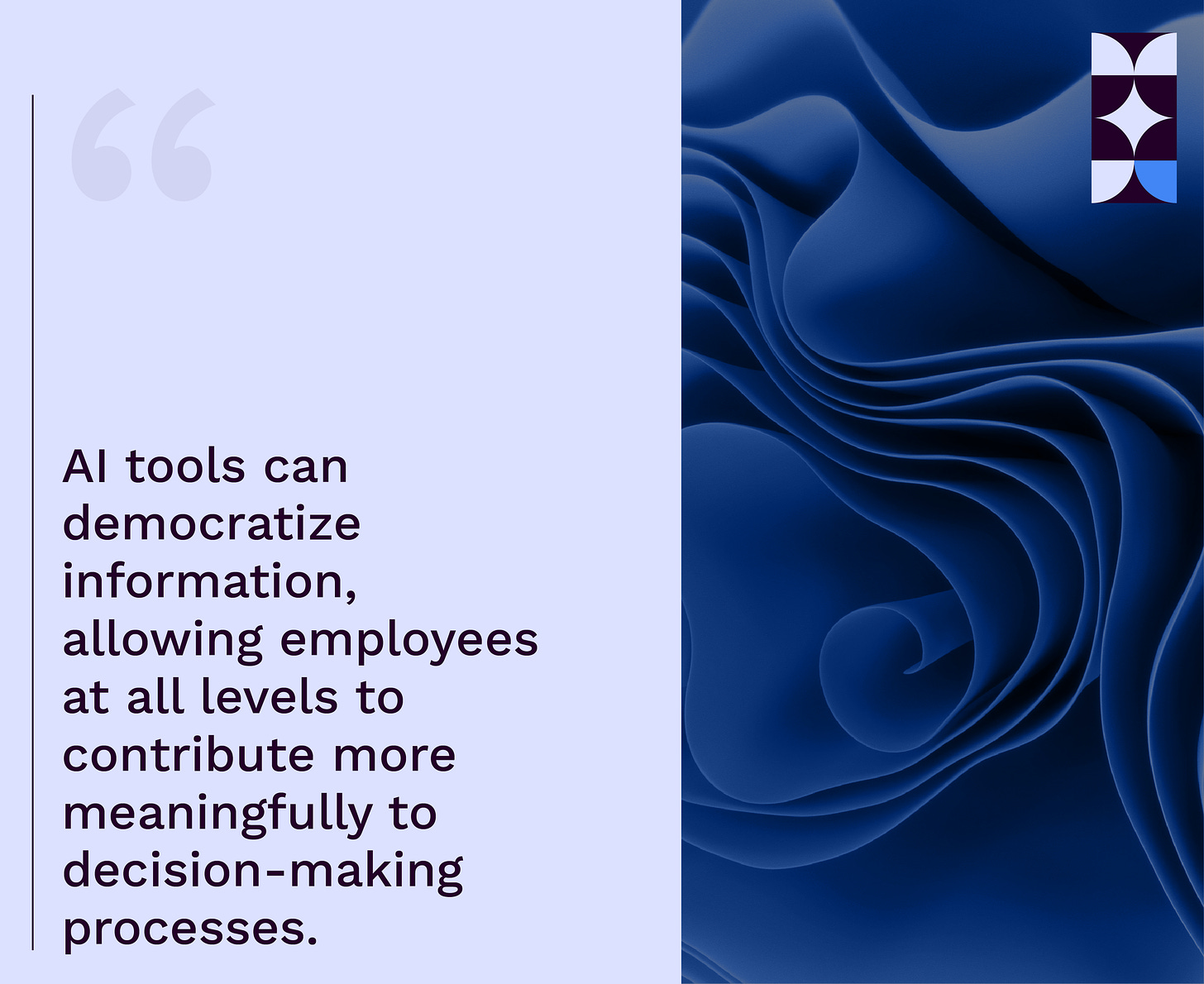“Navigating the AI revolution: corporate transformation and the future of work”
How leaders and companies are leveraging technology to drive positive change and innovation and foster collaboration in the age of AI, in an interview with Henrik Totterman.
The rise of generative AI presents both unprecedented opportunities and potential challenges for businesses. Leaders have a crucial role to play in ensuring a smooth transition, fostering a culture where AI empowers employees rather than replacing them. This involves transparent communication, targeted training, and a focus on hybrid roles that combine human expertise with AI capabilities.
By embracing continuous learning and prioritizing employee well-being, organizations can navigate the AI revolution while maximizing its potential for innovation and growth. However, it's equally important to acknowledge the potential pitfalls, such as biases in AI algorithms and the risk of over-reliance on technology.
Ultimately, the successful integration of AI hinges on a human-centric approach that prioritizes ethical considerations and employee experience.
Today we’re surfing with Henrik Totterman, Entrepreneurial Management Professor at Hult International Business School.
How can corporate leadership ensure that generative AI adoption leads to positive employee experiences and job enrichment, rather than fear of automation and job displacement?
Corporate leadership shapes the narrative and approach to generative AI adoption. Transparent communication, engagement opportunities, tailored training for varying skill levels, and fostering AI champions across the organization are essential. This helps employees view AI as a tool for enhancement, not a replacement for human capabilities.
AI can free employees from repetitive tasks at its best, allowing them to develop their skills by focusing on higher-value work such as creativity, problem-solving, and strategic thinking—areas where human strengths still far surpass AI. By involving employees in pilots and sharing real-life examples of successful AI integration, leadership can help employees understand how AI can enrich their roles and provide avenues for career growth.
Transparency is key. Employees should be involved early in discussions about how AI will be used, which tasks it will automate, and how this aligns with organizational goals. This fosters trust and prevents fear or misinformation from spreading. Additionally, investing in continuous learning programs ensures employees are equipped to work alongside AI, expanding their skill sets rather than rendering them obsolete.
Focusing on creating hybrid roles—where human judgment and AI-driven insights complement each other—promotes a positive experience. For example, we recently tested an HR simulation with an AI-driven avatar to handle difficult employee dialogues. The actual situation struck me, and I could easily see how this training could be scaled across the organization with minimal cost and effort.
Finally, leaders must be role models by embracing AI and emerging technologies. When leaders visibly support and engage with new tools, it signals to employees that these technologies are central to the organization’s future, reinforcing the need to stay ahead of the curve.
How can an organization prepare its employees to work alongside the new technologies? Considering that are emerging new skills and roles related to them.
Organizations must first assess the balance between current and future-required skills. This begins by defining the competencies that will be critical moving forward and comparing these with the current skill sets of employees. I often use various personal and peer assessment tools to identify behaviors, the scope of current tasks, and developmental priorities aligned with individual preferences.
A successful preparation strategy hinges on fostering a culture of continuous learning and adaptability. Employees should be encouraged to adopt a growth mindset and, particularly in the initial phases, to self-organize through exploration rather than have new technologies imposed top-down—unless the business demands it. Organizations can support this by offering access to training platforms, certification programs, and workshops on AI capacity alongside more timeless skills like critical thinking, creativity, and emotional intelligence, which will remain vital even as AI advances.
Business unit champions and cross-functional collaboration are also effective ways to prepare employees. By creating interdisciplinary teams that unite experts from various domains—technology, marketing, operations, and more—organizations can facilitate knowledge sharing and expose employees to different perspectives on how AI can enhance their work. This collaborative environment also allows for experimentation with AI tools in a low-risk setting, enabling employees to gain practical experience while understanding the broader implications of AI across the business.
Does Generative AI impact the workplace culture? In terms of collaboration, communication, or employee relationships.
Absolutely. AI has the potential to reshape workplace culture in profound ways, and it’s important to introduce it with careful consideration. Like remote work, AI can boost productivity, but it can also negatively affect collaboration, communication, and employee relationships—at least in the traditional sense. At its best, AI increases access to timely, relevant knowledge and data-driven insights that may have been previously inaccessible. AI tools can democratize information, allowing employees at all levels to contribute more meaningfully to decision-making processes. For instance, many companies I work with have innovation platforms that allow employees across the organization to make customer-driven contributions.
Regarding employee relationships, AI can create both positive and negative dynamics. AI-driven personalization in areas such as learning and development can increase engagement and job satisfaction. However, if AI is perceived as a threat to job security or a tool for surveillance, it can breed mistrust and resentment. Transparency is crucial—employees need to understand how AI is being used and its limitations, with an emphasis on supporting, not controlling, the workplace environment.
There’s a challenge of over-reliance on technology for communication and task management. While AI can streamline processes, it’s important to recognize that systems may not be agile enough when sudden disruptions occur. We’ve seen this, for instance, with various airports recently, where reverting to manual processes during system failures leads to major operational challenges, especially as there are not nearly enough humans to step in. What is more, the human element—empathy, leadership, and judgment—cannot be replaced by AI. This is why I advocate for companies to invest in AI that enhances, rather than replaces, human interactions. I also warmly recommend companies to have extensive risk assessment in place with rapid execution capabilities when systems fail.
In your opinion, does the use of Generative AI lead to any significant changes in employee morale or job satisfaction?
Generative AI can have a significant impact depending on how it’s introduced and integrated into the organization. When used thoughtfully, AI can enhance job satisfaction by automating repetitive tasks and allowing employees to focus on more meaningful work. However, AI can also lead to anxiety and stress, particularly if employees fear job displacement or feel overwhelmed by the pace of technological change.
Another issue arises from the use of publicly accessible AI tools for work-related purposes. I recently met with start-up founders developing a “digital fence” to protect employer data. Their goal is to balance securing proprietary data with allowing employees to benefit from AI tools. Data security is a growing concern, and employees may unintentionally compromise it by using AI without considering the consequences. This highlights the importance of clear policies around AI use to protect both employees and employers.
How do you see Generative AI influencing diversity, equity, and inclusion efforts within corporate environments?
As with any system, process, or tool, AI has the potential to both advance and hinder DEI efforts in corporate environments. We must be extra careful when applying AI in any context with a risk of bias, subjectivity, or discrimination. For instance, I can see that AI can help in sorting data in recruitment, promotion, and performance evaluation processes. Still, I would be very cautious in relying solely on generative AI to analyze the data for decision-making.
In that sense, AI in this example is no different from traditional psychometric tests, which are useful but foremost as one of several indicators to validate the candidate. It’s our obligation as leaders to avoid shortcuts and to realize the shortcomings of the present technologies, as every decision made in our organizations has consequences.
Has AI changed how leaders interact with teams or make strategic decisions?
Especially in larger organizations, AI and data visualization capabilities influence expectation setting and strategic decision-making. I often hear leaders in smaller organizations talk about needing more AI capabilities or access to relevant data. Also, leaders in large organizations talk about their team’s extensive efforts to clean data for smooth AI processing. So perhaps it is fair to say the grade of change depends and varies from case to case. What is more common is the desire for data-driven decision-making that allows leaders to make more informed and, often, quicker decisions. However, generative AI relies primarily on historical data, which is not particularly useful when forming a decision that relates to the future.
I think the most significant shift is how communication occurs between leaders and their teams. Individuals use generative AI extensively in preparing internal documentation, client-related communication, and regulatory filings. For instance, AI-powered tools generate real-time reports on performance, customer feedback, or market trends, providing leaders and teams with actionable insights during meetings.
AI speeds up the groundwork but does not replace the need for human interaction and judgment in decision-making, nor does it execute these decisions. That said, it’s a bit concerning if we get to a situation where team members prepare documents with AI and their leaders also prepare their responses with AI. In other words, I believe the most effective employees and leaders use AI as a tool to enhance their work, not as a substitute for their expertise and leadership instincts.
How do you anticipate Generative AI will shape the future of corporate organizations in the next 5 to 10 years?
I am confident we will see a lot of experimentation when applying generative AI to tackle mundane tasks and overcome labor shortages. I think we will grow more realistic in applying generative AI, realizing that it mainly applies to some specific tasks. Still, we will also experience disappointments, especially when dealing with dynamic, unpredictable situations that require iterative and creative solutions that build on the present and, preferably, future scenarios rather than the past. I also hope we will create more energy-efficient ways to process generative AI. Hopefully, we will find ways to reduce hallucinations with better algorithms and a more substantial reliance on real-time data.
Henrik Totterman, D.Sc, is a Finnish-American fifth-generation entrepreneur and an internationally awarded professor of practice. He is a former family business owner, dean, and global business school executive director. Henrik has lived since 2010 in Boston and is a recognized international business leader, entrepreneur, and expert in solving organizational challenges for corporations, non-profits, and academic organizations worldwide. Henrik is on the faculty of Hult International Business School, Harvard University, the CEO of Leadx3m, and the Honorary Consul of Finland to the City of Boston and New England (MA, ME, NH, RI, VT).




